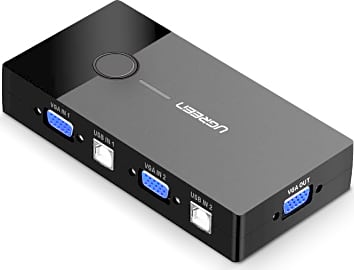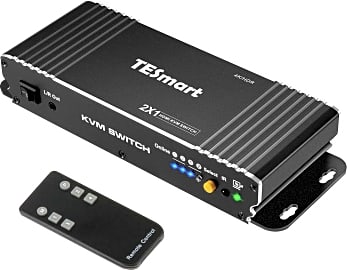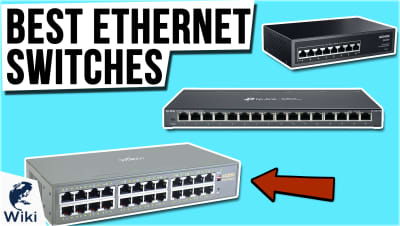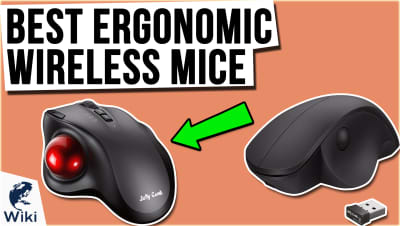The 7 Best KVM Switches

This wiki has been updated 41 times since it was first published in May of 2016. If you're trying to scale down your data center's hardware, maximize your desktop space, or increase the IT department's efficiency, one of these KVM switches may be what you need. Depending on the model, they support HDMI, DVI, or VGA connections, while giving you the freedom to switch seamlessly between multiple computer systems using a single mouse, keyboard, and monitor. When users buy our independently chosen editorial choices, we may earn commissions to help fund the Wiki.
Editor's Notes
January 29, 2021:
If you absolutely need features like UHD resolutions and HDR metadata passthrough for scenarios like home theater setups, the TESmart HKS0401, TESmart 0201, and E-SDS 4K are worth a look. If your requirements are more utilitarian, the reasonably priced UGreen 2 in 1 and JideTech CKL-41UA should be on your list. We really like the relatively recent IOGear GUS4C2, though, which is, in a way, a reverse docking station that streamlines control of a laptop and desktop PC and allows for easy communication between the two.
August 29, 2019:
KVM switches are typically used in IT scenarios, for example, to control an entire rack of servers or configure multiple enterprise PCs at once. Depending on how many devices you need to control, the TNP, CKLau, and JideTech will serve that purpose well. If you only need to access two computers with the same set of input devices, UGreen makes a couple excellent choices for doing so.
Then there are home users, who may be using two computers at once for a variety of reasons. In that case, TESmart makes two of the most feature-packed options, and in fact they make a couple with full HDMI 2.0 compatibility that allows for 4K operation and even supports HDR metadata. If it's not meant for UHD entertainment, TrendNet makes one that's suitable for consumers as well. Also, we especially like the E-SDS because it has one dedicated USB port each for keyboard and mouse, and then two additional USB ports for other peripherals; most models only have a single USB port for things like printers and dongles.
Special Honors
Multiplicity Multiplicity is one of the more comprehensive software-based multi-PC management suites. It connects multiple devices over a LAN, is compatible with VPNs, and uses highly secure 256-bit encryption. It is a bit costly, but many users find it more effective than hardware options, in part because it can be updated with bug fixes and accommodations for new operating system features. stardock.com
Lite Manager This is technically a remote access software suite, and while it's not ideal for server management, it's perfect for real or virtual offices with an IT professional who needs access to everyone's desktop. It lets you take full control of employees' computers and install security updates, fix problems, and even reinstall entire operating systems. litemanager.com
Connect And Succeed
Passive switches are typically hardwired internally between their input and output ports.
The majority of consumers in today's technological world are familiar with a single computer setup. A person using a desktop computer, for example, has a central processing unit (CPU) tower that houses the major internal components of their system, a keyboard, mouse, and a video monitor to complete their work. The same can be said for the laptop user. Everything needed to complete tasks on a laptop is in one place with fully-integrated processing power and connections for peripherals. By contrast, a graphic design artist might require the ability to work seamlessly across two different operating systems with the ability to control them using a single workstation. The KVM switch can make this possible.
KVM is an acronym for keyboard, video, and mouse. The KVM switch is a piece of hardware that allows for the toggled control of multiple computer CPUs or servers from a single keyboard, mouse, and video monitor using either a rotary dial or several independent buttons on the switch itself. Think of the KVM switch as a centralized communication hub (or the parent device) that can be used to take control over other machines and servers (its children devices) without forcing the user to get up, go over to the machines, and control them independently using separate keyboards and mice. A majority of KVM switches can control between two and eight computers at a time.
Computers can be connected to a KVM switch in a variety of ways. The most popular connection method is through the use of a specialized KVM cable that combines all of the keyboard, video, and mouse cables into a single extension cable that runs to each machine. This connection method reduces the number of cables required. Other switches may have separate built-in connectors for each machine's keyboard, video, and mouse cables.
KVM switches are either active or passive. Passive switches are typically hardwired internally between their input and output ports. Computers connected to a passive switch are selected manually using a rotary knob on the switch itself. Active switches are more common and they retain the actions performed by the devices (keyboards and mice) connected to them. Active switches are either powered by the connected computers' keyboard cables or they may have their own separate power supplies.
The KVM switch offers many benefits. Firstly, the CPUs (or servers) connected to the device are not required to have the same amount of memory or processing power between them. In fact, they don't even have to be from the same manufacturer. The device significantly improves work productivity by decreasing the amount of time required of a user to switch between computers manually. The switch also reduces both energy and hardware costs, given that a worker no longer has to depend on the use of multiple video monitors (or additional peripherals) to complete their work from different workstations. This convenience comes in particularly handy when space is limited, when various tasks need to be completed quickly, and in situations where the user is responsible for controlling many machines at once.
Ditch The Hitch And Get A Switch
Because the KVM switch can be applied to many different circumstances and job profiles, one must really take their time to research and determine the type of switch that works best for their individual needs.
Consider the number of machines you'll need to connect to your KVM switch.
If you're a graphic designer or your job requires you to switch between different operating systems at the push of a button, then a switch with the capability to interface with both Mac and Windows machines will be the way to go. The good news is that many switches already do this as part of their basic functionality.
Consider the number of machines you'll need to connect to your KVM switch. If you are a telecommuter and plan to manage both your work and home machines but no others, then you won't need the fanciest or most expensive device with extra connection ports. By contrast, if you work as a network administrator with a responsibility for many machines and servers, then you'll want to consider a more robust switch with push-button controls and several available ports. You'll also need to make a determination of the cable system. If you anticipate a significant amount of distance between your switch and the connected hardware, then definitely spring for a device that consolidates those cables as much as possible. Extender cables for KVM switches can be several hundred feet long, which can help in situations where your server room might be down the hall.
A Brief History Of KVM Switches
The KVM switch has a history that dates back to the early 1980's, which marked the beginning of the growth of the computer industry in general and the adoption of Microsoft Windows in 1985. Before the mouse became common, and an important part of server switching applications, the original term for the device was a keyboard video switch (or KVS). Server rooms and data centers were faced with the major problem of maintaining huge numbers of keyboards, mice, and video monitors. Back in the 1980's, there was an additional problem caused by all this equipment taking up excessive amounts of server rack space, while forcing computer technicians to physically walk to the servers that needed attention. The very first switches were rudimentary in design and featured push-button interfaces.
Remigius Shatas, founder of the Cybex Computer Products Corporation (which manufactured peripheral switches), expanded the functionality of the KVS to include the mouse by 1995, thus bringing about the modern KVM solution still used today. Around the same time, the universal serial bus (USB) would also become the industry standard for connecting the majority of computer peripherals.
Since the mid-1990's, single-user KVM switches have evolved to include intelligent, on-screen firmware for controlling multiple servers at the same time. The most cutting-edge use for KVM switches today is via remote access over an internet browser.












